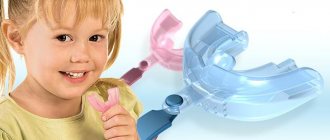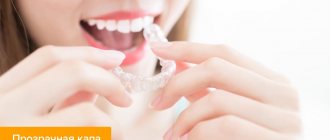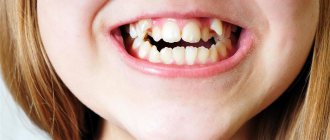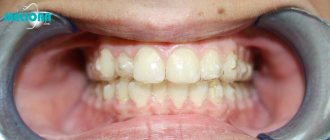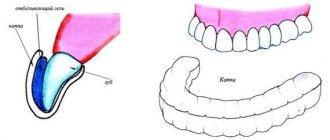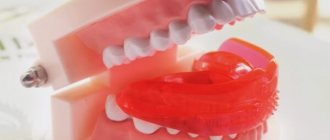Quick bite correction with an invisible orthodontic system.
Correcting teeth with mouth guards is an alternative to braces. The thinnest onlays are made of transparent bioplastic, invisible on the teeth. The caps fit tightly around each tooth, carefully moving pathologically located units into an even smile line. Transparent mouth guards for straightening teeth easily eliminate minor malocclusions and are used as retainers to be worn after removal of orthodontic appliances.
Invisible aligners for teeth straightening: product description
Dental mouth guards are a removable orthodontic structure made of a transparent polymer composition. The second name of the products is aligners. The technology is new, it has been used for just over 15 years, but the achieved treatment results are impressive.
Plastic mouth guards for straightening teeth, like braces, exert targeted physical pressure on incisors, canines, molars and premolars, carefully correcting the dentition. Mouthguards for straightening teeth are given to the patient in a set of 5-30 pieces. Each new aligner placed is a small step towards an ideal bite and smile.
Boxing mouthguard: how to choose and wear dental protection during a fight
During boxing, athletes use dental protection, namely a boxing mouth guard. In this article you will learn how to choose a mouth guard and wear it during combat.
Content:
Why do you need a boxing mouth guard?
A boxing protective plate is a necessary element of an athlete’s equipment. Without it, he will not be allowed to fight. Why is it needed:
- It is designed to protect teeth during combat.
- If a tooth is damaged, the protection will prevent part of it from entering the oral cavity.
- She protects her lips.
- With it, the athlete will not be able to bite his lips or cheeks.
- It also protects against jaw fracture.
By ignoring this type of equipment, an athlete risks damaging his teeth and jaw. The athlete must know how to choose a mouth guard and how to wear it so that it can protect him as much as possible.
How to properly wear a protective plate during combat?
Before putting on a boxing mouthguard, you should prepare it. There are burls that must first be boiled. After which you should adjust it to your jaw, trim off unnecessary parts. There are also protective plates that do not require preparation and can be put on immediately. Once you have a mouthguard specifically for your jaw in your hands, you can start using it.
How to put on a boxing mouthguard:
- Put on the mouth guard and make sure both jaws are closed completely.
- It should sit comfortably on the teeth and cover the teeth and gums tightly.
- If you're comfortable with this skid plate, then it's for you. If there is discomfort during use, the protection should be adjusted or changed.
If you are unable to fit the protective plate comfortably, it may be made by a bad manufacturer. Often, cheap equipment is not comfortable or of good quality, so it will not protect you properly.
Types of boxing guards
Protective plates come in different types and materials. Single-sided - they are designed for the upper jaw. Double-sided - put on two jaws at once. Most often, athletes choose one-sided models; they are the most comfortable and do not make breathing difficult. Double-sided ones are more reliable, but they are harder to breathe with.
The plate size is most often standard. The athlete himself then adjusts it to fit his jaw. Such equipment is most often made from thermosilicone or thermoplastic. The manufacturing material must be plastic under the influence of high temperatures so that the athlete can form equipment to fit his oral cavity. There are standard protective plates that cannot be cooked. They are most often made of silicone, but before purchasing such equipment you should try it on well to see if it fits comfortably.
Boxing mouth guard: how to choose?
Most often, everyone is concerned with the question of how to choose a mouth guard for boxing. First, decide which boxing mouthguard you want to choose in terms of material. Decide whether you will wear the equipment on two or one jaw. After this, you can already pay attention to popular manufacturers and prices.
- If you are a beginner boxer, then simple equipment in a box will suit you just fine. It is inexpensive and will protect you during non-professional fights.
- Adidas mouth guard. Very popular equipment for boxers. It can be easily adjusted to the jaw and is also suitable for beginner athletes.
- Green Hill equipment. This manufacturer is distinguished by the production of enhanced protection, which is useful for frequent knockouts.
- Equipment Gel Max Shock Doctor. This manufacturer produces equipment for professionals. These protective plates are distinguished by a high level of protection, convenience and quality. The equipment has several layers, fits well and is comfortable during battle.
Be sure to use guards when boxing. Carefully study the information on how to choose a boxing mouth guard and wear it in order to provide your oral cavity with the maximum level of protection. Have fun boxing and be safe in all situations.
Mouth guards for teeth correction: types and options
The orthodontist will recommend which mouth guards to install. The selection of products is presented in a variety of categories.
Preparation method
| Custom aligners | Thermoplastic clear aligners |
| Advantages: — created from the patient’s casts; — the treatment plan is 3D designed; — quick bite correction; — the correction period is known in advance; — convenient design; - tight fit; - hypoallergenic; - invisible on the teeth; - easy care. | Advantages: - sold in pharmacies; - are inexpensive; - easy to place on teeth; - universal; - undemanding in care. |
| Disadvantages: - the cost is higher than braces; - you need to wait for the kit to be manufactured. | Disadvantage: - the versatility of the product excludes high-quality correction; - there is a possibility of worsening of the bite. |
Materials
| Silicone aligners for teeth straightening | Bioplastic aligners |
| Advantages: - Low price. — Solving speech therapy problems in children. — Relaxation of the maxillofacial muscles. — Accelerated bite correction. | Advantages: - Thin products that are invisible in the mouth. — Comfortable wearing up to 23 hours a day. — Transparency. - Hypoallergenic. — Strength and rigidity are sufficient to displace dental units. - Easy to care for, wear, put on, take off. |
| Disadvantages: - Increased thickness. - Inconvenience and discomfort. — Indications for short-term wearing. | Disadvantages: - Bioplastic is used only for individual trays for correcting teeth; there are no universal models. |
Wearing time
| Aligners for 24/7 wear | Night guards for teeth straightening |
| Features: — Alignment mouthguards are worn 20-23 hours a day. — Removed for meals and for hygiene care. — Suitable for adults and children. | Features: — Convenient for patients, since aligners only need to be worn at night. — Ineffective for serious pathologies. |
| Indications: — Correction of various anomalies of the dentofacial rows. — Correction of crowded teeth and return of individual units to their proper place in the row. | Indications: - A night guard for straightening teeth acts as a retainer upon completion of orthodontic treatment with braces. — Minor deviations of dental units from the correct position in the bite. |
Patient age
| Clear aligners for adults | Children's mouthguards for teeth straightening |
| Features: — Completely invisible on the teeth even at close range. — Fast and high-quality correction. - Moderate duration of treatment. - Do not require changes in habits - food, sports, personal. | Features: — Mouthguards with color indication to control the required wearing time. — Complete absence of complexes in front of peers. - Does not require getting used to. — Unpretentious in care. — Do not interfere with an active lifestyle. |
Multilayer aligners
More advanced mouth guards are three-layer , made for various sports, including. and for team games, such as hockey. The peculiarity of multilayer mouth guards is that they combine several materials with different characteristics, and therefore different properties.
g
Advantages of individual multilayer trays:
- Improved shock absorption;
- High accuracy of fit;
- Excellent fixation on teeth;
- The ability to adjust the thickness of the protective layer and select shock-absorbing characteristics depending on the type of sport;
- Thanks to the combination of layers with different hardness, the degree of protection during a strong impact increases (following the example of laminated triplex glass);
- Mouthguards not only protect against damage to the dentition and maxillofacial joints, but also reduce the risk of traumatic brain injury.
As an example, let’s look at the Smile Protect line of individual sports mouthguards.
Ultralight aligners - American aligners for teeth straightening
Straightening teeth with Ultralight aligners is a simple way to correct your bite. Suitable for adults and children. Teenagers and their parents like it.
Ultralight aligners - the best aligners for bite alignment
- American brand. The technology was developed by leading US specialists and meets all the canons of international quality.
- 3D modeling of treatment. The correction plan is calculated using a computer program, which eliminates the risk of medical error when correcting occlusion pathology.
- Control of the American side. After receiving the patient’s casts and the initial correction scheme, all information is duplicated in the Ultralight office for verification by American colleagues.
- Manufacturing of aligners at the Skolkovo Innovation Center. In the laboratory of the innovation center, a powerful and high-precision 3D printer creates sets of aligners from biopolymer.
- Save time. The patient receives Ultralight aligners within a few days after the jaw line impressions are taken and can immediately begin wearing clear aligners to straighten teeth.
How long should you wear it and how to care for your mouth guard?
The duration of malocclusion treatment depends on the complexity of the clinical case. On average, correction takes from 10 to 24 months.
Orthodontic aligners for children are easy to use, but there are some features of their operation:
- the product must be stored in a separate container;
- detected traces of deformation and damage on the aligner are a good reason to refuse to wear it and immediately visit a specialist;
- the mouth guard is rinsed with cool water each time it is removed from the jaw;
- In the morning and evening, the device must be washed with regular soap or cleaned with a soft brush using toothpaste without abrasive components;
- The product must be removed before eating;
- It is forbidden to boil the mouth guards or expose them to temperature changes.
By following the listed recommendations, the patient maintains its functionality, which helps to obtain faster and more effective treatment results.
Advantages of transparent aligners for correcting malocclusion
- Convenient – a mouthguard for straightening teeth in adults does not reduce the clarity of speech, does not injure mucous tissue, and is hardly noticeable in the mouth.
- Invisibility - even at a distance of three steps it is difficult to notice the transparent overlay on the teeth of your interlocutor, friend, colleague.
- Safety - aligners fit the teeth, but do not require attachment to the enamel, so there are no cases of damage, abrasion, or decalcification.
- Easy to care for - unlike braces, aligners can be easily cleaned with toothpaste and a soft-bristled brush, and rinsed with water.
Disadvantages of aligners
Every system has its downsides. The unique format of correction with aligners, as well as the materials used, impose their own limitations. Disadvantages of transparent aligners:
- Price. The price depends on the number of products for bite correction and, in case of serious pathologies, exceeds the cost of braces.
- Limited effectiveness. Complex and advanced malocclusions are treated only with braces or combined techniques.
- High level of responsibility. The patient himself controls the wearing time - at least 20-22 hours a day.
Types of mouth guards
- Single-jawed (one-sided) are the most popular. They do not impede the athlete’s breathing and speech, and with the correct fit they are almost not felt in the mouth. For contact martial arts, they are worn on the upper jaw. The choice of professional athletes.
- Double-jawed (double-jawed) protect better than single-jawed ones. But due to their design, they make breathing very difficult. Even the air holes don't really help. Suitable for beginners and women - they are maximally protected at the initial level of training.
Why adults and children choose clear aligners to straighten teeth
A teeth aligner for adults is simply irreplaceable:
| Invisible - no one around you will know that orthodontic treatment is being carried out. | Convenient - you can eat your usual foods, drink coffee and wine. | Hypoallergenic – the risk of allergies is eliminated, there is no danger to health. |
Teens like aligners because:
| Easy care - all you need to clean the mouth guard is a toothbrush and toothpaste. | Unusual solutions - colored aligners will amaze peers and classmates. | Minimal contacts with doctors - aligners are changed at home according to the schedule. |
Diamondbrite thermoplastic mouth guards
Thermoplastic Diamondbrite mouth guards (2 pcs.)
Diamondbrite thermoplastic trays are designed for application of whitening and remineralizing gels to teeth.
The use of gels to strengthen tooth enamel (such as Tooth Mousse, Dental Resourses, ROCS, etc.) will be most effective if used together with individual aligners. Mouthguards prevent premature washing off of the gel from the surface of the teeth and ensure long-term penetration of the active components into the enamel. This not only makes the procedure more effective, but also saves gel.
Diamondbrite is a blank for making a custom mouth guard at home. The material from which it is made is thermoplastic, that is, it has the ability to change its hardness under the influence of temperatures. Just by dipping the blank in hot water for a few seconds and then putting it on your teeth, you will get a mouth guard that perfectly follows the shape of your dentition. It is much simpler, more convenient and cheaper than ordering a mouth guard at a dental clinic.
The mouthguard is intended for reusable use. It is recommended to replace the mouthguard every 3-4 months.
Characteristics
Advantages: It is convenient to use the gel, since you do not eat it. Soft, very comfortable on my sensitive gums. Easy to wash and conveniently stored in a case.
Disadvantages: Not usual. Difficult to customize, the instructions weren't very helpful. A little big, but this is probably individual for each mouth.
Comment: The mouthguards are quite dense. I bought Rox gel for demineralization of teeth. I tried for a very long time to get them into the right shape. The first 2 times in water of 80 degrees I did not get any special changes. Then I put them in boiling water, and it turned out great on the upper jaw. Of course, it does not follow every curve, but the holes for the teeth are slightly visible, and it holds tightly and does not fall off during conversation. What can we say about a mouthguard for the lower jaw? She shrank in size and did not want to take the desired shape. After the 4th attempt, I left it as is, more or less similar to the top one, but it falls off and is terribly inconvenient. Overall, I consider them a good purchase, at least the gel in them works very well. And the rest of the inconveniences are not that significant, you can tolerate it for 30 minutes.
Pros: Storage case
Disadvantages: “tailoring” the mouth guards to your teeth is problematic. I redid it 4 times.
Comment: I use it together with the remineralization gel. Comfortable.
Advantages: reusable, easy to make, adheres well to teeth. Another plus is that the case is included, so you don’t have to look for a box to store the mouthguard yourself
Disadvantages: none found
Comment: strengthening gels are convenient to use with such a mouthguard
Advantages: A beautiful plastic case, which, in fact, is no longer needed.
Disadvantages: Useless thing - I did everything according to the instructions, the material of the mouthguard did not react in any way to water of 80 degrees. It was not possible to press the shape of the teeth; the mouthguard was only slightly modified and did not stick to the teeth. I tried to make the water hotter - the mouthguard shrank in size and still couldn’t be pressed to fit the shape of my teeth. I wasted 650 rubles, I would have been better off buying good pasta.
Comment: Wasted money
Advantages: Reusable.
Comment: A good, easy-to-use product for home whitening or strengthening teeth.
Diamondbrite Thermoplastic Mouthguards
Diamondbrite thermoplastic trays for whitening and remineralizing gels
Diamondbrite thermoplastic silicone trays for home use of whitening and remineralizing gels. Many remineralizing gels, such as Tooth Mousse Gel or fluoridating gels, require the use of special custom trays for maximum effectiveness. Such mouthguards not only increase the benefits of the remineralization procedure, but also make the procedure more comfortable, and also contribute to significant savings in gels.
Many at-home teeth whitening kits may also not include thermoplastic at-home trays (such as Lapiss or Yotuel Patient whitening kits).
You can order individual silicone mouth guards from your dentist, but the disadvantages of this approach are obvious: not every clinic has vacuum forming machines for making mouth guards, and where such a machine is available, the service for making mouth guards can cost from 3,000 rubles and more.
Why overpay and waste time if you can make exactly the same mouth guards yourself at home in just a couple of minutes? Using the kit, you can make your own silicone aligners that will fit perfectly on your teeth! The set includes two blanks for making aligners (for the upper and lower jaws), a stylish case for storing ready-made aligners.
Instructions for making custom Diamondbrite silicone mouthguards Fill a glass with hot (but not boiling!) water at a temperature of 70-80 C° Holding the mouthguard blank by the handle, lower it into the water for 30 seconds. Take out the workpiece, make sure it is not very hot. Place the blank on the top row of teeth. Crimp the blank onto your teeth from the outside and inside with your fingers so that it takes the shape of the jaw. Rinse the finished mouthguard under running cold water to fix its shape. Place the mouthguard on your teeth, making sure that it fits evenly and tightly enough to the dentition. If you did everything correctly, the mouthguard will stay on your teeth without falling off or interfering with your speech. If the mouthguard does not hold well, it can be reheated in water and the shape adjusted. Cut off the handle mentioned in step 2. Repeat the procedure for making a mouth guard for the lower jaw. Country of origin: China
Diamondbrite thermoplastic mouth guards
By mouthguards we mean removable structures, which are special linings on the surface of the teeth.
Mouthguards can be used for any type of dental treatment, prevention, as well as to protect teeth from damage in traumatic sports.
Mouthguards are divided into 3 types: standard, thermoplastic and individual.
Mouth guards or braces: what to choose to correct your bite
| Aligners | Braces |
| Step-by-step treatment plan and exact time to wear the trays | Only an approximate forecast of the duration of treatment |
| Correction of simple malocclusion or tooth misalignment | Correction of even the most complex dental anomalies |
| Aesthetics, invisible on teeth | All braces are visible in one way or another, except for lingual ones. |
| Painless and quick addiction | Discomfort and pain during the adaptation period |
| Minimum care requirements | Difficult cleaning using numerous brushes and brushes |
| Smooth surface prevents injury | Scratch and injure the oral mucosa |
What types of mouth guards are there and how to choose them?
Globally, all mouth guards are divided into 2 types:
- standard. They are also static. They are of a given shape. These are pads that have already been given a certain shape at the factory, which the mouthguard can never change. They are cheaper, but if a fighter has a non-standard jaw or “fenced” teeth, it may simply not fit or not perform its functions;
- thermoplastic. This is a “semi-finished product” of the lining, which still needs to be “prepared” (as they say “welded”) for use. When exposed to heat, such a mouthguard softens and is able to take the shape of a particular person’s jaw, taking into account all its characteristics. Professional wrestlers and boxers love such mouthguards, because safety comes first in competitions.
Professional video tips for choosing mouth guards:
Treatment of malocclusion using aligners
The installation of a mouthguard is performed only on healthy teeth, so a mandatory step in the preparation of the dentition is the treatment of caries and pulpitis, plaque removal and professional cleaning.
In trusted Moscow dental clinics, the stages of bite correction in adults and children include:
- Initial visit to the orthodontist. The doctor will evaluate the bite and condition of the teeth and refer you for a mandatory x-ray examination. The main goal of this stage is to determine the feasibility of installing transparent aligners and the possibility of correcting the identified malocclusion pathology.
- Taking impressions and treatment planning. The orthodontist creates a 3D computer model and designs the correction step by step. The patient sees in the program how the position of the teeth changes and the dental rows are straightened. Simultaneously calculates the number of aligners and the amount for treatment.
- Production of caps The period depends on the manufacturers. For Italian and American aligners manufactured abroad, patients wait up to 2-4 weeks. Orthodontic devices created in Skolkovo near Moscow are ready in a few days.
- Get to know your aligners and get a replacement schedule for your aligners. The orthodontist teaches the patient how to put on and take off the aligners, explains the care technique, and explains when it is necessary to change one product and not another.
- Aligners straighten teeth - wearing aligners and watching how the bite straightens every week.
How to properly brew a mouthguard for boxing at home?
It will be interesting to know how to cook a mouth guard for boxing for people who are passionate and professionally involved in this spectacular sport. Cooking lovers can relax; this material is for real athletes and boxing fans. A boxing mouth guard is a device used to protect a boxer's teeth and jaw. Mouthguards for protecting teeth come in 2 types, single and double. The single-jawed one is fixed only on the upper jaw, while the double-jawed one has a hole, which helps to facilitate the athlete’s breathing. If the preparation is carried out incorrectly, then the mouth guard will have weak teeth marks; such a device will not be able to provide good protection.
Classification of mouth guards for boxing
Boxing is a sport that often leads to injuries. Mouthguard is an excellent protective and preventive tool. In addition to protecting the teeth and jaw, it protects the athlete from injuries such as rupture of the cheeks, lips, and soft tissues of the oral cavity. Mouthguards should be used in order to:
- stabilize the jaw in a certain position;
- prevent lacerations of the mouth;
- provide protection for the jaw and teeth;
- prevent tracheal obstruction.
The mouthguard helps reduce intracranial pressure. Today you can buy the following types of mouthguards in sports supermarkets:
- Cast. This type of product is the most affordable financially. The difference between this type of mouthguard is that it has a ready-made shape. But not every form fits the individual bite of a particular athlete. In addition, as boxers note, molded mouthguards have an unpleasant smell and taste.
- Molded from special thermoplastic. These products soften at a temperature of 75-95°C. These mouthguards are prepared at home according to special instructions. The cooking method will be described below.
- Prepared yourself. To create this type of mouth guard you will need a spoon and self-hardening material. The material should be poured into a spoon and dipped in boiling water for 40 seconds. Then you need to lower the spoon with the material into cold water and place it in the oral cavity. Grit your teeth and wait until the product hardens, taking the shape of your teeth.
- Made to order. Such mouthguards are more expensive than others, as they are made in a dental clinic. It is these mouthguards that can provide ideal compatibility, comfort and protection.
It is necessary to purchase the product only in specialized stores, this is the only way to protect yourself from counterfeiting.
Master class: how to make mouth guard at home
Once the athlete has chosen the type, you need to decide on the material from which the mouthguard is made. It is better to take a mouthguard of medium density; tooth protection should not be thin and made of a very soft material. The cost of mouth guards varies from 650 to 1,300 rubles, and usually well-known manufacturers supply equipment for athletes to the shelves of sports stores that fully meets the requirements.
As soon as the athlete gets home, the obvious question that comes to his mind is how to cook a mouthguard. There are many types and options for mouth guards, but there is only one way to cook protective products. The cooking instructions are as follows:
- The first step is to prepare two pans, one should contain very cold water, the other boiling water.
- The next stage of preparation is to place the product in a pan with very hot water and leave for about half a minute.
- After 30 seconds have passed, the mouthguard must be shaped anatomically to fit the teeth of the boxer who is doing the preparation. To do this, you need to put the mouth guard in your mouth and clench your teeth as hard as possible.
- You need to keep the mouthguard in your mouth for about 5 minutes.
- The last step is to immerse the tray in very cold water, thereby hardening the impression.
You can check whether the mouth guard is made correctly by placing it in your mouth; it should sit comfortably, only in this way will the mouth guard provide full protection of the jaw from blows from an opponent.
Cooking rules
Before cooking a burl, you should carefully study a number of rules that will prevent unforgivable mistakes. So, the rules are as follows:
- If the mouthguard is overcooked, it will have to be thrown away, because an incorrectly prepared product will never return to its original shape. It is still possible to prepare the mouthguard, but it will not be possible to restore the overcooked device.
- When placing the mouthguard in very hot water, it should not be completely immersed. The sports product should simply float on top.
- When clenching your teeth, you cannot move your jaws; you must fix the mouth guard very tightly and wait the required amount of time - 5 minutes.
If the mouthguard is prepared according to the rules, then it:
- will have distinct imprints;
- will adhere perfectly even to the upper teeth;
- will not create discomfort for the athlete.
If you carefully study how to cook kapa correctly, the result will be excellent.
How to prepare a children's mouthguard for boxing
A children's mouthguard is prepared in exactly the same way as a product for an adult athlete. However, such protective devices should be selected very carefully; a good product should include a hygienic storage case. The mouth guard itself should not be toxic, and the most acceptable option is to make custom-made children’s protective equipment at a dental clinic.
In conclusion, it is worth noting the importance of preparing mouth guards for children. If the mouth guard is prepared at home, it is important to maintain sterility during preparation. It is important to ensure that the child does not unclench his teeth while fixing the impression. If you follow the rules, you will definitely be able to make good protection, and the little athlete will be able to confidently enter the ring without fear for the condition of his teeth.
How to put a mouthguard on your teeth for boxing
How to properly brew a mouthguard for boxing?
By and large, all these mouth guards need to be cooked the same way; there is no significant difference in this process, regardless of the brand and purpose. Almost always, the mouth guard comes with instructions for use and cooking, which are best to read.
- it is necessary to boil water in a small container, but sufficient for the mouthpiece to fit entirely and be covered with water;
- the mouthguard should be placed in water for no more than 30 seconds;
- you need to remove the mouthguard and wait. until it burns your mouth. But don’t let it cool down either. Then put it on your teeth and squeeze it tightly, and roll the outer sides over your teeth with your fingers.
- The correct readiness of the mouth guard can be judged by the fact that when it has cooled down, it sits comfortably and tightly on the teeth and does not fall off when opening the mouth.
As a result of the right actions, you will get an individual pad that will reliably protect you for a long time.
To begin, pour water (without a drip cap) into a metal cup or pan and bring it to a boil. A container with cold water should be prepared. After bringing the water to a boil, you need to place a mouth guard in it and leave it there for a period of twenty seconds to a minute. Different boxers recommend different times, but 30-35 seconds is considered optimal.
After this, you need to lower it into cold water and hold it there for up to five minutes. This will allow the mold to set. After the mouthguard has cooled, you can put it on again to ensure its quality. It should fit as tightly as possible, be comfortable and (for single-jawed ones) easily stay on one jaw without the support of the second. In case of unsuccessful welding, it is advisable to repeat the process, since a poorly welded burl can cause serious injury.
A mouth guard is a piece of personal equipment worn by an athlete to protect his teeth. It protects teeth by distributing impact energy over the entire area.
Separately, we reviewed an article about what mouth guards are and how to choose them, but today we will talk about how to properly weld a mouth guard to provide better protection.
Protection ensures uniform distribution of impact energy over the entire area of the teeth.
The photo below shows the mouth guard of model 3535 Zelart before brewing - you will receive it in this format after purchase, but it is not yet ready for use. Each athlete has an individual bite and must be repeated to ensure correct and better protection.
Why do you need a mouth guard?
“Take care of your teeth from a young age,” dentists recommend to us, simultaneously advertising number 1 toothpastes in the world and other oral care devices. But is it only dentists who worry about the condition of their teeth? It turns out that there are activities where teeth require additional protection. And we are not talking about fluoridation of enamel, but about protecting teeth from knocking them out. These are fighting sports: boxing, hand-to-hand combat, combat sambo and other types of martial arts where striking techniques are used.
A person grows new teeth only twice in his life, so the loss of teeth in adulthood is, alas, irreversible. But this is not the worst thing in battle - it is much worse when fragments of teeth get into the respiratory tract, creating a serious threat to the life and health of a fighter. In addition, impacts can damage soft tissues on the face: labral tears, severe gum deformation, jaw bone fractures.
It is very strange that, given the obvious traumatic danger of martial arts for the maxillofacial bones and teeth, real protection - a wrestling mouthguard (also known as a protective pad) - came into use relatively recently - in the 80s of the last century, and almost immediately a mandatory condition for exiting the use of a mouth guard began to be used in the ring.
Among the uninitiated there is an opinion that the mouthguard is intended only to protect the fighter from the loss of precious teeth. However, in addition to this function, a good mouth guard also performs the following tasks:
- prevents lacerations on the lips. The fact is that lacerations are the most difficult for medical treatment and the longest to heal. The mouthguard softens the blow to the lip;
- reduces the likelihood of a fighter’s concussion, again due to shock absorption and softening of the blow;
- the same shock absorption of the mouth guard almost completely prevents displacement of the cervical vertebrae - a very traumatic phenomenon;
- reduces the likelihood of bleeding into the brain;
- even if the teeth are knocked out, they or their fragments will not get into the respiratory tract or the digestive system.
As you can see, a mouth guard is a very small but very useful device that can sometimes literally save a person’s life.
What types of mouth guards are there and how to choose them?
Globally, all mouth guards are divided into 2 types:
- standard. They are also static. They are of a given shape. These are pads that have already been given a certain shape at the factory, which the mouthguard can never change. They are cheaper, but if a fighter has a non-standard jaw or “fenced” teeth, it may simply not fit or not perform its functions;
- thermoplastic. This is a “semi-finished product” of the lining, which still needs to be “prepared” (as they say “welded”) for use. When exposed to heat, such a mouthguard softens and is able to take the shape of a particular person’s jaw, taking into account all its characteristics. Professional wrestlers and boxers love such mouthguards, because safety comes first in competitions.
Stage No. 1. Preparatory
It is necessary to boil water and pour it into a separate container.
Let the water cool slightly to 90-85 degrees Celsius.
Place the mouthguard in water for 30-90 seconds depending on the mouthguard (thickness) and manufacturer's recommendations.
The mouthguard floats in the water and we use a spoon to keep it completely submerged.
Important: do not literally boil the mouth guard, do not pour boiling water over the mouth guard, or boil the mouth guard in a saucepan or kettle.
As the temperature rises, the mouthguard becomes “plastic-like.”
Take it out of hot water, dip it in cold water for 1 second and immediately place it on the upper jaw. Usually the back is fixed first, then the front. When the mouthguard sits completely, it is additionally pressed with your fingers to repeat the shape of not only the teeth, but also the jaw as a whole.
Once the impression is formed, place the tray in cold water to harden.
If the mouth guard is double-sided, do not remove the plug from the holes before adjusting the mouth guard to your individual bite.
If the mouthguard does not fit the first time, you can try to go through the procedure from the very beginning. A properly fitted mouthguard (as in the picture) will stay on the athlete's upper jaw without any restraint.
There are two types of mouth guards for braces: silicone or thermoplastic. Silicone mouthguards do not require special adjustment and are fixed on the upper jaw without cooking. Hot melt burls undergo a classic cooking procedure. In any case, we recommend following the manufacturer's instructions.
What other requirements apply to good mouthguards?
- color. Oddly enough, it matters here. The main thing is that it is light and not red. All this is done so that dangerous damage can be noticed in time;
- absence of smell, taste, aroma, etc. These characteristics must be at an absolutely zero level, because over time they begin to irritate the owner, or even cause allergic reactions;
- The pad should not be felt in your mouth at all. Indeed: good mouth guards do not cause any pain, do not cause discomfort, do not interfere with speaking, breathing, or hinder movements;
- You should choose a rubber according to the sport you are playing. Wrestling mouthguards will be uncomfortable for hockey players and vice versa. Mouthguards differ even by gender: male and female.
We can immediately make a reservation that it is definitely not recommended to buy mouth guards from Adidas. Yes, an old world brand that produces excellent sporting goods somehow turned out to be weak in the production of protective dental guards. This is exactly the rare case when you simply throw money away by being fooled by a brand.
Inexpensive models
Common mistakes
It is possible to cook a kapa incorrectly, but it is difficult. Usually errors are associated with incorrect temperature conditions in which the tray is placed.
The mouthguard has become hard - either you placed it in cold water (or not hot enough), or it was left for a long time at a high temperature of about 100 degrees Celsius.
The mouth guard began to form pimples - as in the previous version, this is only possible by keeping it in boiling water for a long time.
The burl melted - a common mistake when cooking cheap thin burls. Such mouthguards melt easily when exposed to high temperatures. In order to cook them correctly, you need to follow the recommended water temperature and the time the mouthguard is in it.

